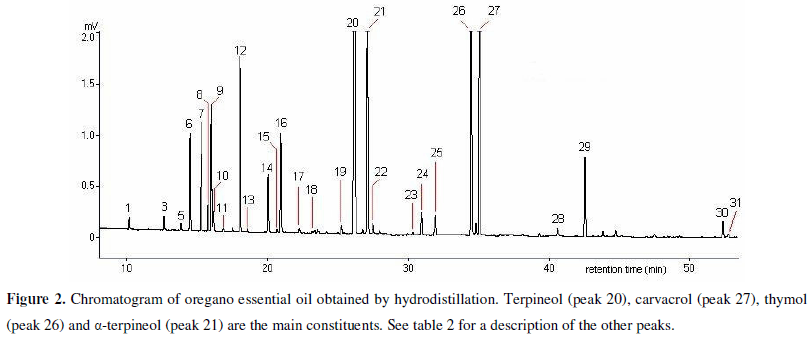The aim of this study was to evaluate the in vitro activity of the essential oil extracted from Origanum vulgare against sixteen Candida species isolates. Standard strains tested comprised C. albicans (ATCC strains 44858, 4053, 18804 and 3691), C. parapsilosis (ATCC 22019), C. krusei (ATCC 34135), C. lusitaniae (ATCC 34449) and C. dubliniensis (ATCC MY646). Six Candida albicans isolates from the vaginal mucous membrane of female dogs, one isolate from the cutaneous tegument of a dog and one isolate of a capuchin monkey were tested in parallel. A broth microdilution technique (CLSI) was used, and the inoculum concentration was adjusted to 5 x 10(6) CFU mL-1. The essential oil was obtained by hydrodistillation in a Clevenger apparatus and analyzed by gas chromatography. Susceptibility was expressed as Minimal Inhibitory Concentration (MIC) and Minimal Fungicidal Concentration (MFC). All isolates tested in vitro were sensitive to O. vulgare essential oil. The chromatographic analysis revealed that the main compounds present in the essential oil were 4-terpineol (47.95%), carvacrol (9.42%), thymol (8.42%) and □-terpineol (7.57%). C. albicans isolates obtained from animal mucous membranes exhibited MIC and MFC values of 2.72 µL mL-1 and 5 µL mL-1, respectively. MIC and MFC values for C. albicans standard strains were 2.97 µL mL-1 and 3.54 µL mL-1, respectively. The MIC and MFC for non-albicans species were 2.10 µL mL-1 and 2.97 µL mL-1, respectively. The antifungal activity of O. vulgare essential oil against Candida spp. observed in vitro suggests its administration may represent an alternative treatment for candidiasis.
Candida; Origanum vulgare; essential oil; in vitro




